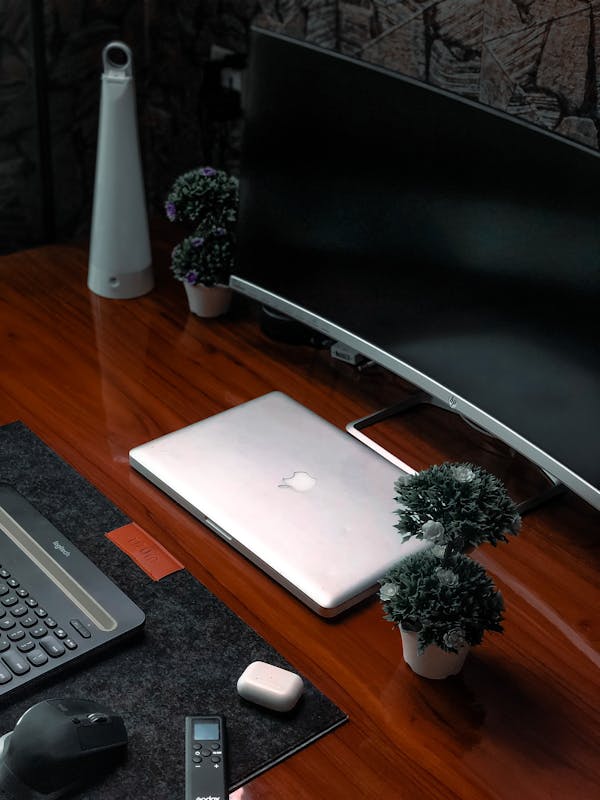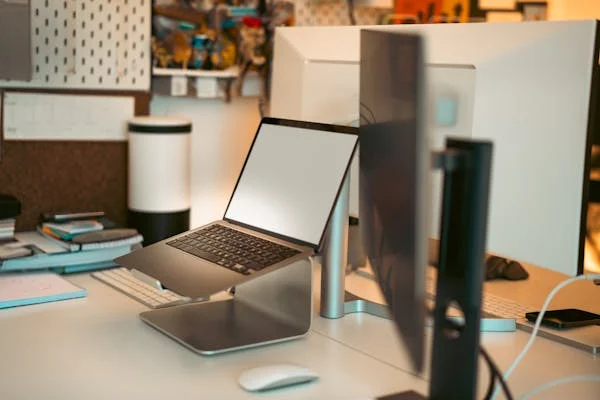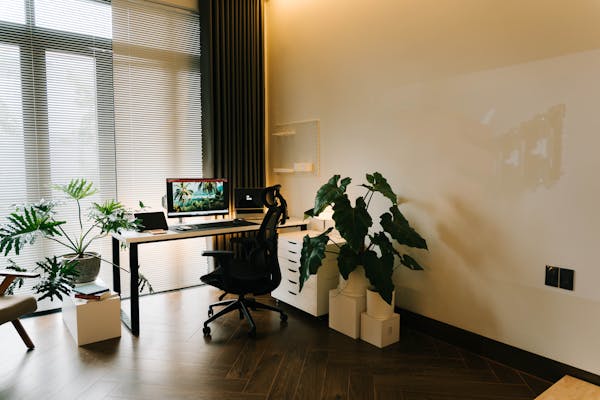10 Simple Steps to Create an Ergonomic Home Office for Maximum Comfort
Working from home has become the new norm, offering flexibility but also posing challenges—especially when it comes to maintaining a healthy and productive workspace. Creating an ergonomic home office isn’t just about investing in an expensive chair; it’s about crafting a well-designed environment that supports your body, promotes better posture, and enhances your overall well-being. A ergonomic home office is essential for those looking to minimize discomfort and maximize productivity while working remotely.
Let’s dive into how you can transform your home workspace into an ergonomic haven that caters to your comfort and work needs.
What is Ergonomics?
Ergonomics is the science of designing tools, systems, and environments that align with the natural movements of the human body. In the context of a ergonomic home office, it’s about adjusting your workspace to reduce strain, prevent injuries, and optimize comfort. Implementing ergonomic principles in your home office can lead to long-term health benefits, improved work efficiency, and enhanced focus. Simply put, an ergonomic home office is a setup that ensures your workspace works for you—minimizing physical stress and maximizing your ability to work.
Benefits of an Ergonomic Home Office
Setting up an ergonomic home office offers a range of physical and mental health benefits that can make your workday more enjoyable and productive.
- Physical Health: The right ergonomic home office setup can help alleviate common issues like back pain, neck strain, and repetitive stress injuries. With proper furniture and equipment, your body remains in a more natural, less strained position, promoting better circulation and comfort.
- Mental Well-Being: A comfortable workspace in an ergonomic home office reduces stress and anxiety, allowing you to focus on your tasks without physical discomfort. A well-designed ergonomic environment leads to fewer distractions, both physical and mental, enhancing your overall mood and concentration.
- Improved Productivity: A functional ergonomic home office can significantly increase your productivity. By promoting good posture, comfort, and convenience, you’ll find yourself working more efficiently, with less need for breaks to stretch or relieve pain. A well-organized ergonomic home office also reduces clutter and distractions, helping you maintain focus on important tasks.
1. Assessing Your Space
Before you set up your ergonomic home office, it’s crucial to evaluate your available space to ensure it meets ergonomic standards. This is the first step to creating a comfortable and supportive workspace.
Choosing the Right Location
- Quiet and Well-Lit Area: Select a quiet, well-lit corner of your home that allows you to concentrate. Natural lighting is ideal, as it can reduce eye strain and fatigue. If possible, position your desk near a window to take advantage of natural light in your ergonomic home office.
- Accessibility to Power and Wi-Fi: Ensure the location of your ergonomic home office has easy access to electrical outlets and a strong Wi-Fi signal. This setup will prevent you from having to stretch cords or deal with unreliable connections, both of which can disrupt your workflow.
Measuring for Comfort
- Desk Height: A comfortable desk height is critical for an ergonomic home office. Measure your desk to ensure it’s between 28–30 inches high to prevent strain on your arms and wrists. You should be able to work with your elbows at a 90-degree angle, minimizing any discomfort during long work sessions.
- Chair and Monitor Placement: Adjust your chair and monitor placement to achieve proper alignment. Your monitor should be at eye level to avoid neck strain, and your chair should allow your feet to rest flat on the floor, keeping your knees at a right angle. Proper alignment is key in an ergonomic home office setup.
2. Selecting Ergonomic Furniture
When designing an ergonomic home office, the right furniture is crucial. The items you choose will directly affect your physical comfort and posture throughout the workday.
Ergonomic Office Chair
- Look for a ergonomic home office chair with adjustable lumbar support to provide adequate lower back support. This helps maintain the natural curve of your spine, reducing the risk of back pain.
- Seat Height and Position: Ensure the seat height allows your feet to rest flat on the floor and your thighs to be parallel to the ground. This promotes proper circulation and prevents discomfort.
- Armrests: Adjustable armrests that support your arms at a 90-degree angle can help reduce shoulder strain. A comfortable chair is one of the most important investments for your ergonomic home office.
Desk Considerations
- Height and Space: A desk height of 28–30 inches is ideal for most people. In your ergonomic home office, ensure the desk provides enough surface space for your monitor, keyboard, mouse, and other essentials.
- Ergonomic Desk Setup: Consider a desk with cable management features to avoid clutter and reduce distractions. A clutter-free ergonomic home office helps you focus and reduces stress.
Standing Desks and Converters
- Standing Desks: Incorporating a standing desk into your ergonomic home office encourages movement throughout the day, reducing the negative effects of sitting for long periods. Look for models that allow you to easily switch between sitting and standing positions.
- Desk Converters: If a full-standing desk isn’t an option, consider a desk converter. These adjustable units can raise your monitor to eye level and encourage standing, even with a traditional desk setup.
3. Optimizing Your Workstation for Maximum Comfort
Beyond furniture, optimizing your ergonomic home office workstation setup is key for overall comfort and efficiency. Small adjustments can make a big difference in your workday experience.
- Keyboard and Mouse Positioning: Keep your keyboard and mouse at the same height as your elbows. This reduces strain on your wrists and forearms, making it easier to work without discomfort.
- Monitor Placement: Your monitor should be directly in front of you, with the top of the screen at eye level. This minimizes neck strain, as you won’t have to look down or strain your eyes to view the screen.
- Footrests and Support Tools: If your chair doesn’t allow your feet to rest flat on the floor, invest in a footrest. Additionally, consider using a wrist rest to alleviate strain on your wrists while typing.
4. Optimizing Keyboard and Mouse Placement
Correct positioning of your keyboard and mouse is essential to creating a healthy ergonomic home office. Improper alignment can lead to wrist, arm, and shoulder strain, causing discomfort and long-term issues such as carpal tunnel syndrome.
Keyboard Position
- Optimal Arm Alignment: For the most ergonomic setup, place your keyboard at a height that allows your arms to be at a 90-degree angle when typing. Your elbows should be kept close to your body to prevent strain on the shoulders. Ensure your hands float above the keyboard in a neutral position, avoiding wrist bending that could lead to discomfort.
- Wrist Support: A wrist rest can provide added comfort by keeping your wrists in a neutral position, preventing awkward angles that could lead to strain over time. Opt for a soft, padded wrist rest or one that’s adjustable, ensuring your wrists stay straight while typing, key to your ergonomic home office setup.
Mouse Placement
- At Same Level as Keyboard: Your mouse should be positioned at the same height as your keyboard to ensure you don’t stretch your arm or rotate your wrist excessively. Place the mouse within easy reach, ensuring that your forearm remains parallel to the ground.
- Ergonomic Mouse Design: Invest in an ergonomic mouse with a design that supports your natural hand and wrist position. Mice with a vertical grip can help prevent wrist strain, as they allow you to hold the mouse in a more natural, handshake-like position.

5. Lighting and Eye Health
The right lighting is critical in a ergonomic home office to reduce eye strain, headaches, and fatigue, especially if you’re working long hours. Poor lighting can make it difficult to focus and may contribute to poor posture due to squinting and eye discomfort.
Natural vs. Artificial Lighting
- Maximize Natural Light: Position your desk near a window to take advantage of natural light. The bright, soft light reduces the need for artificial lighting, creating a more comfortable and energetic workspace. Studies have shown that natural light boosts mood, increases productivity, and reduces eye strain—key factors for a functional ergonomic home office.
- LED Desk Lamps: If natural light is limited, consider using adjustable LED desk lamps that allow you to direct light to your workspace. Adjustable brightness settings are crucial for reducing glare and creating an optimal work environment.
Reducing Screen Glare
- Use an Anti-Glare Screen Protector: One of the best ways to reduce eye strain in your ergonomic home office is to invest in an anti-glare screen protector for your monitor. This will reduce reflections from overhead lights or windows, ensuring you can focus more effectively without straining your eyes.
- Adjust Monitor Settings: Fine-tune the brightness and contrast of your monitor according to your environment. Your monitor should be bright enough for easy viewing but not so bright that it causes discomfort. Setting your screen to a cooler temperature during the day can also reduce blue light exposure, improving your eye comfort.
6. Personalizing Your Workspace
While ergonomics focuses on physical comfort, personalizing your ergonomic home office can also have a significant impact on your mood and productivity. A well-organized, aesthetically pleasing workspace fosters creativity, reduces stress, and makes you feel more connected to your work.
Plants and Decor
- Incorporate Greenery: Adding plants to your ergonomic home office isn’t just about aesthetics; plants help purify the air, boost your mood, and reduce stress. Studies have shown that even just a few houseplants can increase productivity and cognitive function. Consider low-maintenance plants like succulents or peace lilies to add some life and calm to your space.
- Soothing Colors: Choose calming colors for your decor. Soft blues, greens, or neutral tones can help create a peaceful environment that reduces stress and enhances focus. Avoid overly bright or loud colors, which can be distracting and increase anxiety.
Organization and Storage
- Use Functional Storage: Keep your ergonomic home office organized with storage solutions that keep essential items easily accessible while minimizing clutter. Shelves, filing cabinets, and desk organizers can keep your workspace clean, which has been shown to help with focus and productivity.
- Accessibility of Tools: Place frequently used items, such as your phone, planner, or pens, within easy reach. This prevents unnecessary bending, stretching, or twisting to access your tools, which could lead to discomfort and disrupt your workflow.

7. Creating Healthy Work Habits
Setting up your ergonomic home office is just one piece of the puzzle. To truly reap the benefits of ergonomics, you must also develop healthy work habits that support your physical health and mental well-being throughout the workday.
Regular Breaks
- Follow the 20-20-20 Rule: Prevent eye strain and fatigue by following the 20-20-20 rule. Every 20 minutes, look at something 20 feet away for 20 seconds. This simple habit reduces the risk of digital eye strain and helps your eyes reset, particularly during long periods of screen time in your ergonomic home office.
- Get Up and Move: Standing up and stretching every hour is crucial. Prolonged sitting can lead to poor circulation, back pain, and other musculoskeletal issues. Set a timer or use an app to remind you to take a quick break, stretch, and walk around to maintain your energy levels.
Stretching and Movement
- Neck, Shoulders, and Wrists: Incorporate specific stretches into your daily routine to target the areas most impacted by sitting at a desk for long periods. Focus on your neck, shoulders, wrists, and lower back. These stretches relieve tension and promote better posture, which are essential in maintaining an ergonomic setup.
- Use a Balance Board or Footrest: A balance board encourages you to make subtle movements throughout the day, helping to activate your core and improve posture. A footrest helps you maintain proper leg alignment, preventing back pain and reducing pressure on your lower spine.
8. Adjusting Your Monitor Position for Maximum Comfort
Your ergonomic home office setup isn’t complete without ensuring that your monitor is positioned correctly. A poorly placed screen can lead to a variety of problems, including neck strain, poor posture, and even headaches.
Monitor Height and Distance: Key to Posture
- Ideal Monitor Height: Place the monitor so that the top of the screen is at or just below your eye level. This helps maintain a neutral head position without straining your neck. When you look at the screen, your eyes should naturally fall on the upper third of the screen. If the monitor is too low or too high, you may find yourself constantly tilting your head, which can lead to muscle fatigue and long-term discomfort.
- Monitor Distance: Keep the screen about 20-30 inches (or arm’s length) away from your eyes. This ensures you don’t have to lean forward to read text or strain your eyes to see the content. This distance is ideal for reducing eye fatigue, especially during long hours of screen time.
Optimal Setup for Dual Monitors
- If you use two monitors, place them side by side at the same height and distance from your eyes. A dual monitor ergonomic home office setup can boost productivity, but only if both monitors are at the right position to avoid constantly turning your neck. Consider using a curved monitor setup to maintain a smooth transition from one screen to the next, reducing neck strain. Always ensure your primary monitor is directly in front of you to minimize unnecessary neck movement.

9. Managing Cables and Wires in Your Ergonomic Home Office
An organized ergonomic home office isn’t just about furniture and posture; it also includes managing the cables and wires that clutter your space. A chaotic setup not only distracts you but can also make accessing your equipment awkward and painful.
Cable Management for Comfort and Safety
- Cable Clips and Organizers: Invest in cable clips, ties, or organizers to keep all wires neat and out of your way. For instance, a cable management tray mounted under the desk can hold power strips, chargers, and excess cables, keeping your workspace clutter-free. Avoid having cables draped across your desk or floor where they can trip you up or cause you to twist awkwardly to access your devices.
- Desk and Wall Mounts: Wall-mounted hooks and under-desk cable organizers are ideal for ergonomic home office setups where desk space is limited. They can hold cables, chargers, and even small devices while keeping them easily accessible but not in the way.
Switching to Wireless Devices
Where possible, consider switching to wireless devices like a Bluetooth keyboard, mouse, and speakers. Wireless devices reduce the number of cords on your desk, allowing for smoother, more ergonomic movements without the need to manage tangled cables. This minimalist approach not only looks better but also contributes to a cleaner, more efficient ergonomic home office.
10. Optimizing Temperature and Air Quality for Comfort
An often-overlooked but vital aspect of an ergonomic home office is the temperature and air quality. The right environment can significantly improve your focus, productivity, and overall well-being, helping you feel more comfortable during long hours of work.
Temperature Control for Better Focus
- Ideal Temperature Range: The optimal temperature for an ergonomic home office is typically between 68°F and 72°F (20°C – 22°C). Working in an environment that’s too hot or too cold can lead to discomfort, distractibility, and even fatigue. By maintaining a comfortable room temperature, you’ll reduce the likelihood of temperature-induced discomfort and be able to concentrate for longer periods.
- Portable Fans and Heaters: If you have trouble regulating your room’s temperature, consider using a small, adjustable fan or a portable heater. These can help fine-tune the climate in your ergonomic home office without causing major distractions. However, avoid having direct airflow blowing on you, as it could be distracting and cause tension.
Air Quality and Ventilation
- Using Air Purifiers: High-quality air purifiers help reduce allergens, dust, and pollutants that can make the air stale and uncomfortable to breathe. Cleaner air in your ergonomic home office will help you feel more energized and focused throughout the day.
- Proper Ventilation: Good airflow is essential for maintaining mental clarity and avoiding the sluggishness that can come from stale indoor air. Open a window when possible, or use a fan to improve circulation. Fresh air promotes better sleep at night, improved concentration, and higher productivity during the day.
Humidity Control
Humidity also plays a role in your comfort levels. If the air in your ergonomic home office is too dry, it can cause dry skin, irritated eyes, and difficulty concentrating. A humidifier can add moisture to the air, preventing dryness. On the other hand, if the room feels too humid, a dehumidifier can help control excessive moisture, keeping your workspace pleasant and comfortable.
Conclusion
FAQ
1. What is the most important ergonomic feature in a home office?
A supportive chair with lumbar support is essential for reducing back pain.
2. How high should my monitor be?
The top of the screen should align with your eye level for optimal comfort.
3. Can I use my dining table as a desk?
Yes, but ensure the height is suitable, and add an ergonomic chair to maintain posture.
4. Are standing desks better than sitting desks?
Both are beneficial. An adjustable standing desk lets you switch between positions for better health.
5. What lighting is best for a home office?
Natural light is ideal, but adjustable LED lamps work well for evening hours.
6. How can I reduce eye strain?
Use the 20-20-20 rule and adjust your monitor’s brightness to suit your environment.
7. Are ergonomic accessories worth it?
Yes, items like wrist rests and monitor arms can prevent strain and improve comfort.
8. How do I declutter my workspace?
Invest in storage solutions like shelves and desk organizers to keep everything tidy.



Pingback: 10 Simple Steps to Create Your Perfect Ergonomic Small Room Workspace on a Budget - Design Interior Guide